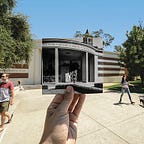Every Hat You Can Imagine
by Madi Gordon
Today we have a blog post from our former student intern-turned-staff member Madi Gordon on her time here at the Fisher Museum.
I would never have guessed when I was a student that I would spend the next two and a half years at Fisher. I am eternally grateful for the opportunities I’ve been given at here.
The museum is my home and my coworkers are my family.
Fisher has allowed me to try on just about every hat you can imagine; curating, teaching, collections management, art handling, installations, and publication editor.
Instead of writing a ton, I’ve decided (in typical curatorial fashion) to share some of my favorite Fisher memories/experiences through photos.
As a student
My involvement at Fisher began in the fall of 2016. I was a student in [museum director] Selma’s museum studies courses, Introduction to Museums: Past, Present & Future and Curatorial Practicum. The spring course, Curatorial Practicum, required my peers, Lauren Jones, Regina Chung, and Adrian Jade Matias Bell and myself to collaboratively curate a permanent collection exhibition in conjunction with Art Division’s Artists in Residence workshops. The aim of the exhibition, Miracles Unknown, was to serve as art historical inspiration for the workshop participants while providing information about Fisher’s collections for our other museum visitors.
As an intern
I applied for an internship at Fisher around the time Miracles Unknown opened and was brought on as an intern for Stephanie Kowalick, Fisher’s Collection Manager, who taught me the essential functions of collection management: how to condition report (and the vocabulary of condition reporting), accessioning objects to the collection, managing the museum’s digital records, monitoring environmental conditions for optimum climate, and best practices for art handling.
Some of the most fun I had as an intern was assisting Fisher’s Chief Preparator, Juan Rojas, install and deinstall exhibitions. I painted walls and display cases, mounted object labels, and spent countless hours peeling thousands of vinyl letters off the wall using a heat-gun and box cutter blade. (As it turns out, removing vinyl for hours at a time was incredibly therapeutic.)
As a staff member
The following summer in 2018, I graduated from USC. Shortly after, Selma and Kay [the museum’s associate director]offered me a chance to use my curatorial and exhibition planning skills to curate a permanent collection exhibition in celebration of Fisher’s 80th anniversary. I worked closely with Selma and Fisher’s staff to develop all aspects of the exhibition that became Staged Meaning/Meaning Staged: Landscapes from Fisher’s Permanent Collection, and gained invaluable insight into the trials and tribulations of exhibition planning.
In addition to my curatorial responsibilities, I was Selma’s teaching assistant for her museum studies classes. Over the course of two semesters, our students explored the museological landscape of Los Angeles, curated the exhibition Suppression, Subversion and the Surreal: The Art of Czechoslovakian Resistance and created the exhibition catalogue, of the same title, based on their scholarly research of a selection of 26 works from the Dr. Eugene Rogolsky Collection.
As a world traveling museum professional
If there’s one thing I can confidently say about my time at Fisher, it’s that there is never a shortage of new challenges or opportunities for growth — and this summer [2019], I had both — when Selma invited me to attend the colloquium, Cátedra Extraordinaria de Museología Crítica William Bullock, with her in Oaxaca, Mexico. In the weeks leading up to the trip, Selma and I worked with Dan McCleary, artist and Founder of Art Division, to develop a curriculum for a workshop about artist residencies held on the second day of the colloquium.
USC Fisher Museum, the British Council Mexico, the National Institute of Fine Arts and Literature (INBAL) of the Ministry of Culture and the Contemporary Art University Museum (MUAC) of the UNAM co-organized the conference, which took place June 14 at the San Pablo Cultural Center, Oaxaca City and June 15 at the Arts Center of San Agustín, Etla.
The second day of the conference was the Artist Residency workshop Selma and I planned. It began with a panel featuring artists and directors of museums and adjacent cultural institutions. After the panel, the workshop attendees broke into three groups, each advised by two of the panelists, and were tasked with proposing an exhibition that applied concepts from the workshop and conference. Each participant was given a deck of 40 cards featuring 20 works selected by Dan McCleary and Demián Florez.
Despite not being fluent in Spanish, I participated as a judge and really enjoyed the proposals the groups came up with. Each concept was completely different from the next. The ingenuity of the participants and panelists made the workshop a success!
Madi Gordon completed her time at the Fisher Museum in July of 2019. We thank her for sharing her remembrances of her time here!
